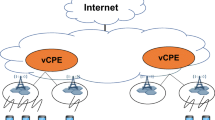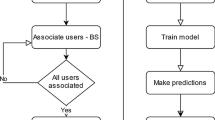Abstract
The problem of predicting the possible loads in a cellular network operation can be reduced to building a forecast on the possible number of calls directed to one gateway (PGW) within the given period of time. Having these data for all gateways in the network, it is possible to organize the optimal distribution of resources, prevent overloading of the gateways and, as a result, failures in the entire network operation. A statistical analysis of actual data collected by automated measuring systems on the nodes of a mobile network is carried out and the most suitable data for building forecasting models are identified. The results of the research on the possibility and effectiveness of the application of the mathematical models realized in constructing such a forecast by using machine learning methods such as linear regression, k-nearest neighbors (KNN), and random forest are presented. It is established that in order to solve the problem of building a short-term forecast on the number of requests that are to enter the server, it is not necessary to use complex models that require computing resources. Based on the calculated quality metrics, it is found that the most accurate forecast can be obtained by using a linear regression model.







Similar content being viewed by others
REFERENCES
V. M. Bezruk, I. V. Korsun, V. A. Tikhonov, and N. V. Kudryavtseva, “Research of the possibilities of forecasting the network traffic of mobile communication,” Vost.–Evr. Zh. Peredovykh Tekhnol., No. 4/9 (46), 58–62 (2010).
X. Du, H. Zhang, H. V. Nguyen, and Z. Han, “Stacked LSTM deep learning model for traffic prediction in Vehicle-to-Vehicle communication,” in Proc. 2017 IEEE 86th Vehicular Technology Conference (VTC-Fall) (T-oronto, 2017), pp. 1–5. https://doi.org/10.1109/VTCFall.2017.8288312
A. R. Abdellah, O. A. K. Mahmood, A. Paramonov, and A. Koucheryavy, “IoT traffic prediction using multi-step ahead prediction with neural network,” in Proc. 2019 11th International Congress on Ultra Modern Telecommunications and Control Systems and Workshops (ICUMT) (Dublin, 2019), pp. 1–4. https://doi.org/10.1109/ICUMT48472.2019.8970675
L. Paradis and Q. Han, “A survey of fault management in wireless sensor networks,” J. Network Syst. Manage. 15 (2), 171–190 (2007). https://doi.org/10.1007/s10922-007-9062-0
M. E. M. Cayamcela and W. Lim, “Artificial intelligence in 5G technology: A survey,” in Proc. 2018 Int. Conf. on Information and Communication Technology Convergence (ICTC) (Jeju, South Korea, 2018), pp. 860–865. https://doi.org/10.1109/ICTC.2018.8539642
J. E. P. Box and G. M. Jenkins, Time Series Analysis: Forecasting and Control (Holden-Day, San Francisco, 1970).
T. Hastie, R. Tibshirani, and J. Friedman, The Elements of Statistical Learning: Data Mining, Inference, and Prediction, 2nd ed. (Springer, New York, 2009). https://doi.org/10.1007/978-0-387-84858-7
E. Z. Demidenko, Linear and Nonlinear Regression (Finansy i Statistika, Moscow, 1981) [in Russian].
S. Fortmann-Roe, Accurately Measuring Model Prediction Error (2012). http://scott.fortmann-roe.com /docs/MeasuringError.html.
M. Mullin and R. Sukthankar, “Complete cross-validation for nearest neighbor classifiers,” in Proc. 17th International Conference on Machine Learning (ICML’00) (Morgan Kaufmann, San Francisco, CA, 2000), pp. 639–646. https://doi.org/10.5555/645529.658292
L. Breiman, “Random Forests,” Mach. Learn. 45 (1), 5−32 (2001). https://doi.org/10.1023/A:1010933404324
R. E. Ildiiarov and I. V. Semenova, “Application of the multiple regression in predicting the overload of mobile operators’ servers,” in XXV Tupolev Readings (School of Young Scientists): Proc. Int. Youth Scientific Conference (Kazan, 2021), Vol. 5 (Izd. IP Sagieva A.R., Kazan, 2021), pp. 309−312.
Author information
Authors and Affiliations
Corresponding authors
Ethics declarations
The authors declare that they have no conflicts of interest.
Rights and permissions
About this article
Cite this article
Semenova, I.V., Ildiyarov, R.E. Study on the Efficiency of Models Forecasting the Load on the Servers of a Cellular Operator. Math Models Comput Simul 15, 677–685 (2023). https://doi.org/10.1134/S2070048223040154
Received:
Revised:
Accepted:
Published:
Issue Date:
DOI: https://doi.org/10.1134/S2070048223040154




